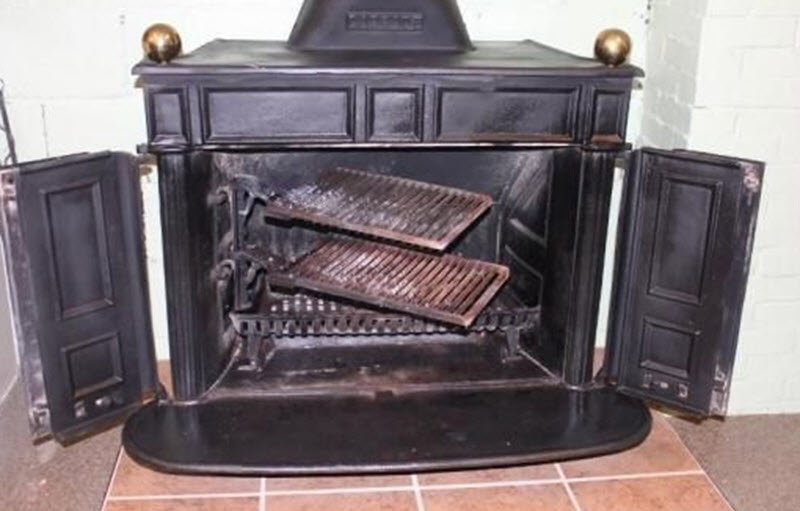The Franklin stove, an ingenious invention by Benjamin Franklin, revolutionized the way people experienced heating in their homes. Introduced during one of the coldest winters in history, this innovative fireplace design allowed colonists to enjoy superior warmth while using less wood—a remarkable feat in the context of 18th-century environmental challenges. Franklin’s contributions to historical technology extend beyond mere comfort; they provided insights into atmospheric phenomena, laying groundwork for future climate adaptation discussions. As we explore the intersections between Franklin’s inventions and their influence on environmental history, it becomes evident that the Franklin stove is more than just a heating device—it’s a symbol of human ingenuity against the backdrop of a changing climate. Through its unique design and efficiency, the Franklin stove not only transformed domestic life but also sparked new conversations about the relationship between technology and our natural world.
Known for its innovative heating capabilities, the Franklin stove represents a significant breakthrough in early American domestic technology. This flat-pack iron stove, crafted by the Great Enlightenment thinker Benjamin Franklin, was designed to enhance the effectiveness of traditional fireplaces, allowing households to conserve fuel while maximizing warmth. Moreover, it played a pivotal role in shaping discussions around climate challenges during the Little Ice Age, highlighting early efforts toward climate adaptation. By examining how Franklin’s work impacted public understanding of environmental issues, we begin to see the stove as a catalyst for advancing knowledge about weather and atmosphere, and not merely a source of heat. In tracing the legacy of such inventions, we uncover a narrative that connects historical figures like Franklin to present-day concerns about sustainability and environmental responsibility.
The Significance of the Franklin Stove in Environmental History
Benjamin Franklin’s invention, the Franklin stove, emerged as a pivotal breakthrough, particularly during the harsh winter of 1740-41. This invention went beyond mere comfort; it represented a response to the pressing environmental challenges of that time. As colonists faced increasingly difficult winters, Franklin recognized the necessity for an efficient heating system that would minimize wood consumption, a resource that was becoming scarcer due to deforestation. The Franklin stove, designed to produce more heat with less fuel, not only helped households stay warm but also illustrated an early understanding of sustainability in energy use—a concept that resonates strongly in today’s environmental discourse.
The implications of the Franklin stove extend into the broader narrative of Benjamin Franklin’s contributions to technology and science. By innovating a heating solution that was both efficient and practical, Franklin laid the foundation for future advancements in environmental technology. His work in understanding atmospheric phenomena, linked to the operation of the stove, showcases how early inventors applied their insights to tackle pressing environmental issues. This historical context prompts a reevaluation of the Franklin stove not just as a household item, but as an early experiment in climate adaptation and energy efficiency.
Franklin’s Technological Innovations and Their Impact on Climate Adaptation
The technological innovations introduced by Benjamin Franklin, especially represented by the Franklin stove, highlight how early American thinkers adapted to their climate. During the Little Ice Age, Franklin’s stove was a direct response to the severe weather that impacted food supply and living conditions. The design emphasized the importance of maximizing heat while minimizing environmental impact—a concept that aligns with current discussions on climate adaptation and resilience. With Franklin’s insight, colonists could meet the challenges of their environment, foreshadowing modern approaches to sustainable living.
Moreover, Franklin’s inventions are a fascinating intersection of technological advancement and environmental awareness. As he sought more effective means of heating, he inadvertently contributed to conversations about energy use and environmental responsibility. The shift from wood to coal in his designs also reflects a broader narrative in environmental history: the ongoing struggle between technological progress and ecological conservation. This highlights the enduring legacy of Franklin’s approach—emphasizing that solutions to climate challenges must be multifaceted, requiring both innovation and a strong sense of responsibility toward the earth.
The Role of the Franklin Stove in Advancing Scientific Thought
The Franklin stove not only revolutionized heating in homes but also advanced scientific understanding of atmospheric phenomena. Franklin utilized the principles of convection and heat transfer to explain how warm air needs to circulate effectively. In doing so, he bridged the gap between practical invention and theoretical science, illustrating how everyday technology could facilitate comprehension of natural processes. His ability to articulate complex ideas about atmospheric movement resonated with the larger educational goals of his time, unfurling the mysteries of both indoor heating and outdoor weather patterns.
In fact, Franklin’s description of how the Franklin stove operated served not just as a technical manual but as a means of democratizing science for the public. With phrases that connected natural phenomena to human invention, Franklin created an accessible narrative that educated a diverse audience. This melding of science and utility is an essential motif in the history of technology, showcasing how innovations like the Franklin stove can catalyze broader scientific discussions and engage communities in understanding their environment.
Lessons from Franklin’s Innovations for Modern Technology
Franklin’s inventions provide a crucial lens through which we can view modern technological advancements. His acknowledgment of the impact of emissions from his stove on air quality reflects a concern for public health that remains relevant today as we grapple with climate change and pollution. Franklin’s efforts in sustainability, particularly his attempts to reduce smoke emissions, remind us of the need for contemporary solutions to be both innovative and responsible. As we continue to explore ways to mitigate environmental impact, the principles held by Franklin serve as a guiding framework for modern inventors and environmentalists alike.
Today, as we pursue various technologies to combat climate issues, we should take heed of Franklin’s philosophy. He embraced a multi-faceted approach, aware that no single solution could adequately address the complex challenges of his time. This calls for a contemporary perspective that values a multitude of technological interventions rather than relying on a singular ‘silver bullet’ approach. Just as Franklin explored various inventions, today’s innovators must collaborate across disciplines to develop integrated solutions that protect our environment while enhancing quality of life.
Franklin Stove as a Reflection of Enlightenment Confidence
The Franklin stove stands as a testament to the Enlightenment era’s confidence in science and technology as tools for improvement. During a period marked by rigid environmental circumstances, Franklin’s design embodying efficiency and warmth reflects an optimistic belief in human ingenuity. This stove not only served practical needs but also symbolized a belief in progress—a core tenet of Enlightenment thinking. As people today face their own climate and environmental crises, this spirit of innovation continues to inspire responses that incorporate science and creativity.
Franklin’s resolve to enhance human comfort through scientific progress showcases how technology can serve as a vehicle for societal change. The stove illustrated that science could meet the demands of everyday life, shaping not only personal environments but societal structures as well. In embracing the advancements of his age, Franklin sparked a broader dialogue about the interplay between human activity and the natural world, a conversation that persists in contemporary contexts as societies seek to navigate the complexities of climate adaptation and technological advancement.
Exploring the Societal Impact of Benjamin Franklin’s Stove
The societal impact of the Franklin stove extends beyond mere practicality; it highlights the evolving relationship between technology and daily life in the 18th century. By offering a more efficient heating solution, Franklin inadvertently improved living conditions during harsh winters, contributing to social well-being. The stove’s introduction also mirrored a shift in colonial attitudes towards resource conservation, prompting families to reconsider their wood consumption amidst growing populations and environmental changes. The societal implications of this innovation reflect a burgeoning awareness of environmental stewardship in the context of domestic life.
Moreover, the Franklin stove influenced social dynamics, as it became a tool for comfort and community during difficult times. Families could gather around a reliable source of heat, fostering social bonds and enhancing familial interactions. The invention thus had cultural ramifications, creating spaces for togetherness while navigating environmental stresses. Franklin’s interoperability of technology and social function illustrates his profound understanding of humanity’s dependence on nature, echoing modern aspirations for sustainable living and community resilience.
Comparing Franklin’s Stove to Other Historical Technologies
When examining the Franklin stove, it’s insightful to compare it to other historical technologies. Similar to inventions like the steam engine or the cotton gin, the Franklin stove was born out of necessity, addressing immediate social and environmental challenges. While these technologies marked significant advancements in their respective fields, Franklin’s stove was particularly unique in its dual role as both a scientific experiment and a practical household appliance. This comparison sheds light on how various technologies emerged from historical contexts, each motivated by a desire to improve everyday life and adapt to the changes imposed by nature.
The core of Franklin’s invention also aligns with the pursuit of efficiency observed in many technological advancements. Just as the steam engine revolutionized transportation by optimizing fuel use, the Franklin stove optimized heating, contributing to broader discussions of energy consumption. By exploring these parallels, we can appreciate the interconnectedness of technological progress throughout history, where each invention builds upon the lessons learned from predecessors—an enduring theme that highlights the continuous human endeavor to solve problems through innovation.
Franklin Stove’s Contribution to Understanding Atmospheric Phenomena
The interplay between the Franklin stove and atmospheric phenomena represents a significant advancement in early American science. Franklin’s application of heat transfer principles not only improved how homes were heated but also provided insights into outdoor atmospheric conditions. His work on convection laid the groundwork for understanding weather patterns, demonstrating how domestic innovations could contribute to scientific inquiry. This connection underscores the importance of household inventions in delivering practical knowledge that voyages beyond the walls of individual homes to impact broader scientific practices.
By using the stove as a metaphor for atmospheric currents, Franklin fostered a unique understanding of how indoor heating could relate to outdoor conditions. His writings suggested that home heating principles could be applied to explain larger weather systems, contributing to the foundation of meteorology as a discipline. This duality of function—where a simple heating device could catalyze complex scientific exploration—highlights the significance of everyday inventions. It reminds us that innovations can be both functional and educational, linking human needs to the enigmatic forces of nature.
Exploring the Ethical Dimensions of Franklin’s Inventions
The ethical dimensions surrounding Benjamin Franklin’s inventions, including the Franklin stove, provide a critical lens through which to analyze technology’s role in society. While Franklin aimed to enhance human comfort and efficiency, he did so against a backdrop of societal injustices, including slavery, which played a significant role in the production of his inventions. This juxtaposition prompts deeper reflection on the moral responsibilities of inventors: the need to consider who benefits from technological advancements and at what cost. As environmental challenges persist today, such reflections are increasingly relevant in discussions of ethical innovation.
Moreover, Franklin’s recognition of the need for cleaner air and efficient energy use speaks to a burgeoning environmental ethic. His concern for the air quality in urban areas illustrates an awareness of the health implications stemming from industrial practices—a precursor to modern environmental movements. This awareness urges contemporary society to critically assess the ethical implications of technological development, ensuring that progress does not come at the expense of community health or ecological balance. Ultimately, Franklin’s legacy prompts us to engage with the ethical frameworks that should guide innovation, especially in light of urgent climate considerations.
Frequently Asked Questions
What is the Franklin stove and how does it relate to Benjamin Franklin’s inventions?
The Franklin stove, invented by Benjamin Franklin in the early 18th century, is a revolutionary heating device designed to improve indoor heating while being more fuel-efficient than traditional fireplaces. This historical technology demonstrates Franklin’s ingenuity as it utilizes a design that promotes better air circulation and convection, making rooms warmer without wasting wood—an important feature considering the environmental challenges of his time.
How did the Franklin stove contribute to environmental history?
The Franklin stove is significant in environmental history as it exemplifies early efforts to adapt technology for better climate resilience. Created during the harsh winter of 1740-41, Franklin’s design aimed to reduce wood consumption even as settlers deforested land. This adaptation showcases how environmental challenges can spur technological innovation.
What atmospheric phenomena did Benjamin Franklin explain through the workings of the Franklin stove?
Benjamin Franklin linked the principles of convection used in the Franklin stove to atmospheric phenomena, explaining how warm air rises and how storm systems move along the Atlantic coast. His work with the stove also contributed to his understanding of the Gulf Stream, highlighting his keen interest in the intersection of technology and natural science.
Why is the Franklin stove considered an important historical technology?
The Franklin stove is recognized as important historical technology because it not only improved home heating efficiency but also embodied the Enlightenment ideals of using science and innovation to solve problems. It influenced the development of heating systems and reflected early American ingenuity in addressing climate and energy challenges.
How did the Franklin stove fit into Benjamin Franklin’s life and scientific contributions?
The Franklin stove represents a critical aspect of Benjamin Franklin’s life and his contributions to science and technology. It showcases his commitment to improving daily life through innovation, and its design principles continue to influence modern heating solutions, marking a pivotal point in the evolution of climate adaptation technologies.
What lessons from the Franklin stove are relevant to today’s climate crisis?
The lessons from the Franklin stove highlight the need for multi-faceted approaches to climate adaptation. Similar to Franklin’s cautious exploration of various solutions, today’s efforts must embrace innovation without relying solely on singular technologies or quick fixes, emphasizing collaboration and diversified strategies for sustainability.
How did the design of the Franklin stove aim to minimize smoke emissions?
Benjamin Franklin designed the latter iterations of the Franklin stove to minimize smoke emissions by re-burning smoke particles, improving air quality and efficiency in heating. This forward-thinking approach reflected his concerns about pollution and set a precedent for considering environmental impacts in technological design.
| Key Concept | Details |
|---|---|
| The Franklin Stove | A versatile invention by Benjamin Franklin designed to improve heating efficiency in homes. |
| Historical Context | Developed during the severe winter of 1740-1741 to help colonists cope with cold temperatures. |
| Scientific Contributions | Helped advance understanding of atmospheric science, including explanations of convection and the Gulf Stream. |
| Environmental Considerations | Attempted to minimize smoke emissions, showcasing early awareness of air pollution. |
| Influence on Technology | Sparked new thoughts on technology’s role in addressing climate adaptation and energy efficiency. |
Summary
The Franklin stove is not only a notable invention of Benjamin Franklin but also a crucial element in understanding early American innovation and environmental consideration. This revolutionary stove exemplified Franklin’s forward-thinking approach to heating technology during a time of dire climate challenges. Through his design, Franklin was able to address not just the immediate need for warmth, but also instigate vital conversations about atmospheric science and pollution, marking an important chapter in the history of both science and society.





